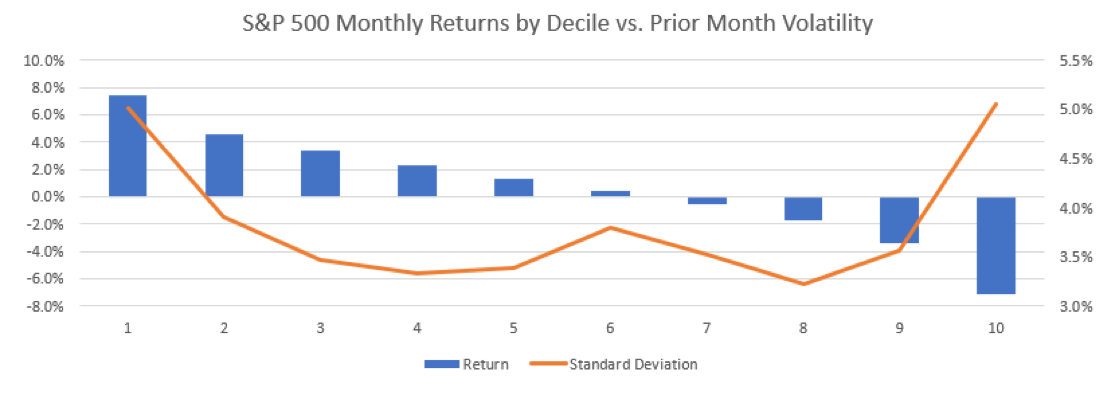By Denis Rezendes, CFA
What is volatility? From a purely technical standpoint, volatility, otherwise known as standard deviation, is a statistical measure of data’s dispersion around its mean. In more simple terms, volatility is a way to measure swings in the price of securities or market indices. But what does that tell us as investors?
In our opinion, volatility measures the level of disagreement among investors. When volatility is high, there is considerable disagreement as to what the future holds. Put differently, investors, in aggregate, believe there is a large distribution of potential outcomes. To illustrate this concept, we took the monthly price returns of the S&P 500, sorted them from highest to lowest, and split the data into ten deciles. Then, for each decile, we calculated the average standard deviation in the *prior* month. The result, which you can see in the chart below, supports our thesis: both the highest and the lowest monthly returns are, on average, preceded by high volatility.
Source: Bloomberg, Beaumont Capital Management (BCM); data is for the time period 1/1/1940-4/30/19.
Volatility may not be able to tell us what the market’s future return will be, but insight into the potential distribution of future returns is still very useful information. Investment math dictates that losses require a larger gain to break even, and this relationship is exponential. A 10% loss requires an 11% gain to break even while a 50% loss requires a 100% gain to break even! This begs the question, if the probability that we will realize an outsized gain or an outsized loss is elevated, should we still invest? We believe the answer is no. In fact, if you were somehow able to invest in only the top and bottom 10% of returns, your annualized return would have been negative.
Successful long-term investing takes place in the middle of the return distribution, and we believe that volatility is a useful tool to help us determine when we are more likely to realize good investment outcomes and less likely to realize bad ones.
This article was contributed by Denis Rezendes, Assistant Portfolio Manager at Beaumont Capital Management, a participant in the ETF Strategist Channel.
For more insights like these, visit BCM’s blog at blog.investbcm.com.
Sources & Disclosures:
Copyright © 2019 Beaumont Financial Partners, LLC DBA Beaumont Capital Management (BCM). All rights reserved.
As with all investments, there are associated inherent risks including loss of principal. An investment cannot be made directly in an index. Performance data shown represents past performance and is no guarantee of future results.
This material is for informational purposes only. It is not intended as an offer or solicitation for the purchase or sale of any security or financial instrument, nor should it be construed as financial or investment advice. The material may contain forward or backward-looking statements regarding intent, or beliefs regarding current or past expectations. The views expressed are also subject to change based on market and other conditions.


